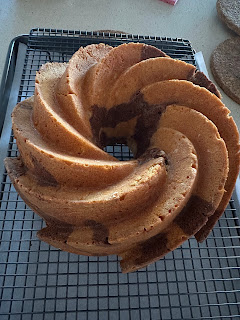I am quite a fan of soft and fluffy breads such as milk bread and Tangzong. I have researched various versions including preferments comparison, milk bread comparison post and also Tangzong and cream comparison post. The condensed milk version was difficult to work with, the Korean version was fabulous but took 3 proves so very time-consuming, and sponge method (also very time-consuming) worked for speciality filling breads but failed for bread loaf perhaps due to either over-working or over-proofing.
I decided to try this recipe by Bear Naked Food as it only has 2 proves and uses a mix of cake and bread flour to achieve the soft pillowy texture. It is very similar to this more voluminous Chinese milk loaf recipe which uses both types of flours and heavy cream, but that method was more complicated and a little dry and denser without the oil. This recipe uses milk powder and whipping cream with total 300g of flours (yielding between 560 to 610g dough), it will fit nicely into my Pullman tin!
Ingredients
270g bread flour
30g cake flour
5g instant yeast
40g sugar
4g salt
15g milk powder
25g egg (save the rest of the egg for egg wash + 1tbsp milk)
140ml milk (additional if required)
75ml whipping cream
Method
1. Mix flours, sugar, salt and milk powder with balloon whisk in KA bowl. Add instant yeast and mix again.
2. Create a well and pour in the 25g egg, milk and whipping cream. Combine with wooden spatula until mixed. Cover with cling wrap to rest for 20 mins at room temp.
3. Turn on the KA at low until mixed in. Turn up to medium and mix for 10 to 15 mins. If it seems too dry, drizzle in more milk slowly. Keep scraping down so the dough doesn't climb up the hook.
4. When the dough is shiny and not tacky, as well as passes the window pane test, it's ready.
5. Invert out onto the bench top and slam it against the benchtop 10 times. Ball up and put back into the oiled KA bowl and cover. Allow to prove for 45 to 60 minutes until doubled in size.
6. When doubled, invert onto dusted benchtop. Divide and shape into 4 balls. Cover and rest for 5 mins. During this time, prepare the bread loaf tin by buttering inside.
7. With a rolling pin, poll into rectangular disc and turn over. Repeat so both sides are smooth.
8. Roll into a cigar shape and roll out. Repeat. (see video for method) for each of the dough balls.
9. Place into lightly greased bread tin.
10. Cover and allow to rise for 40 to 50 minutes in a warm place.
11. Mix leftover egg with 1 tbsp milk and gently egg wash the top. Be sparing so as the top doesn't burn and be careful not to deflate.
12. Bake at 170 deg C for 30 - 40 minutes until puffed up and golden brown; turning halfway. Tent the top if it's browning too quickly.
13. Once out of the oven, brush with whipping cream (optional).
14. After about 10 mins cooling in the tin, invert bread onto a cooling rack. Allow to fully cool before slicing.
14. Bread can be stored at room temp for up to 3 days. Otherwise, cling wrap and store in the fridge for up to a week.







































